Traditionalist Issues
 |
 |
 |
 |
 |
 |
 |
Dialogue Mass - XCVIII
The Loreto Tradition Blighted by ‘Ecumenism’
On March 5, 2016, the seventh centenary of the foundation of the Loreto Basilica, Greek Schismatic leaders of Albania, Georgia, Greece, Romania, Russia and Serbia gathered for prayer at the Holy House together with the papal delegation and representatives of Greek Schismatics of Italy and Malta. The prayers were led by Metropolitan Zervos Gennadios, Greek Schismatic Archbishop of Italy, in the presence of Msgr. Giovanni Tonucci, Archbishop of Loreto and Pontifical Delegate to the Basilica.
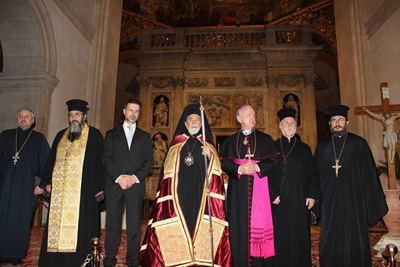 The syncretist meeting was preceded by a Conference highlighting the importance of the Greek city of Arta, capital of the old Despotate of Epirus, where the stones of the Holy House were alleged to have arrived in 1291.
The syncretist meeting was preceded by a Conference highlighting the importance of the Greek city of Arta, capital of the old Despotate of Epirus, where the stones of the Holy House were alleged to have arrived in 1291.
Metropolitan Gennadios, appealing to abstract concepts of universalism and vague ideals of global unity, described the meeting as a “glorious stage” in Byzantine history. This was a reference to the completely unsupported hypothesis that members of the Schismatic Angeli family were instrumental in transporting the Holy House from Nazareth to Loreto in the 13th century, not via Dalmatia and Italy, but via Athens and various towns in Greece.
But this represents a dilemma for religious unity. Gennadios can hardly be said to have been motivated by benevolence and brotherly sentiments. While living in Italy (his seat was in Naples), he was only interested in promoting Greek nationalism and giving credit to members of his own religion for having transported the Holy House from Nazareth. His approach was simply a form of chauvinist identity politics, an attempt to upstage the Catholic tradition.
In his address, Msgr. Tonucci referred to the Schismatic confessions as “sister Oriental Churches (“le sorelle Chiese orientali”). (1) Casting aside the Catholic tradition of angelic agency, he stated that they have “historical links with the Holy House of Loreto through the events that led to the transfer of the holy stones from the East to the western coasts of the Adriatic.” (2)
Hermeneutic of discontinuity
A significant feature of the Loreto meeting is the complicity of the Pontifical Delegation and its leader in the task of estranging the faithful from their tradition and history of the miraculous translation of the Holy House.
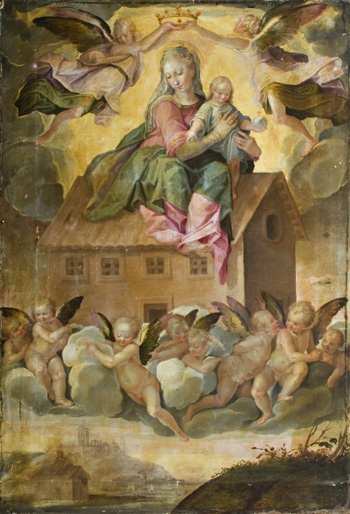 Msgr. Tonucci did not evince any care or concern for the Catholic tradition that had been faithfully passed on chiefly by Jesuits and Franciscans, or any desire to acknowledge the shared allegiance of the Catholic faithful to a purely supernatural explanation.
Msgr. Tonucci did not evince any care or concern for the Catholic tradition that had been faithfully passed on chiefly by Jesuits and Franciscans, or any desire to acknowledge the shared allegiance of the Catholic faithful to a purely supernatural explanation.
The question arises: Was he actively working towards the demise of that tradition? As the defining issue of Loreto was the translation of the Holy House by purely supernatural means, Tonucci’s statement – echoed by Santarelli (3) – is nothing less than the destruction of that tradition. Besides, if the Holy House was transported by ship, where does that leave Our Lady of Loreto as Patroness of air travel?
Paradoxically, this crusade to downplay the miraculous element of the Loreto tradition seeks to place its interpretation in the hands of those outside the fold. It was so successful that all progressivist media outlets, from official Vatican authorities to the Catholic Press and even to secular tourist agencies, now portray the Byzantine Angeli family as the true protagonists in the translation of the Holy House. The Catholic tradition has been eclipsed.
Who started the anti-Loreto legend?
It will come as no surprise to find that it was the Angeli family itself, whose present head is Prince Alessio Angelo Comneno of Thessaly, Greece. He confidently asserted: “‘It was not the heavenly angels, but the Angeli family, who brought the Holy House to Loreto’ ‒ so said my grandfather Michael III [Mario Bernardo Angelo-Comneno] until the end of his days.”
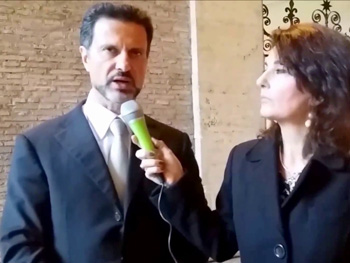 He quoted his grandfather: “You will see, Alessio, that one day we will have the joy of showing that it was our family who saved the Holy House from Muslim invasion.” (4)
He quoted his grandfather: “You will see, Alessio, that one day we will have the joy of showing that it was our family who saved the Holy House from Muslim invasion.” (4)
So, now we know that the “Angeli thesis” was an in-house construct of relatively recent origin, designed to overthrow the centennial and universal Catholic tradition; and that the Angeli were a family with a mission to arrogate to themselves the glory of the translation of the Holy House. (Hence, we have a possible explanation of the mysterious papers rumored to have been seen in the Vatican Archives at the beginning of the 20th century).
Who organized the inter-faith meeting?
The promoter of this event was Prince Alessio, President of the Accademia Angelica Costantiniana, a cultural institute organized in Rome by his grandfather in 1949. Its self-declared aim was to “promote a bridge between the two worlds, the Latin Catholic and the Eastern Byzantine, and a mutual enrichment of spiritual and cultural values.”
The politics of envy
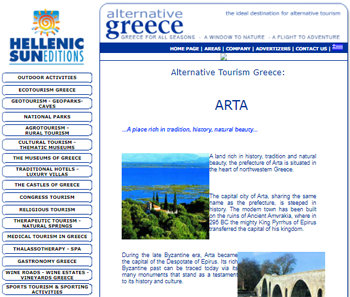 But the bridge turned out to be a conduit for the achievement of self-serving and even mercenary ambitions. The Greek news website, Epirus Gate, covering the event, revealed that the intention was not only to poach pilgrims from Loreto, but also to boost the Greek tourist industry:
But the bridge turned out to be a conduit for the achievement of self-serving and even mercenary ambitions. The Greek news website, Epirus Gate, covering the event, revealed that the intention was not only to poach pilgrims from Loreto, but also to boost the Greek tourist industry:
“The delegation of the Municipality of Arta had on the sidelines of the Conference important meetings with travel agents, in an effort to find a way to divert the flood of visitors from Loreto to Greece and specifically Arta.” (5)
Is this really what the Church has come to, that the official weight of the Pontifical Delegation was directed to pandering to the politics of envy? In order to meet the appropriate level of “ecumenical” targets to satisfy official Vatican II requirements, it was necessary not only to appease but also to believe and disseminate the ideas of those who intended to destroy the Catholic tradition of Loreto. This was principally the role of Fr. Giuseppe Santarelli.
A 21st-century Trojan horse enters Loreto
In his 2016 book on Loreto, (6) Fr. Santarelli introduced and warmly recommended the work of the Greek writer, Haris Koudounas, a member of the Accademia Angelico Costantiniana, who is the mastermind behind the current promotion of the “Angeli thesis.” In fact, it was his research and published results (7) that led to the Loreto Conference and Ecumenical prayer meeting.
Let us examine the main planks of his argument which, on his own admission, are merely hypotheses.
1. An ancient inscription
Koudounas drew attention to a lapidary inscription he discovered in Pyli, Thessaly, in the church of Porta Panagia, (8) which had been built in 1283 by Joannis I Angelos Comneno, ruler of Thessaly.
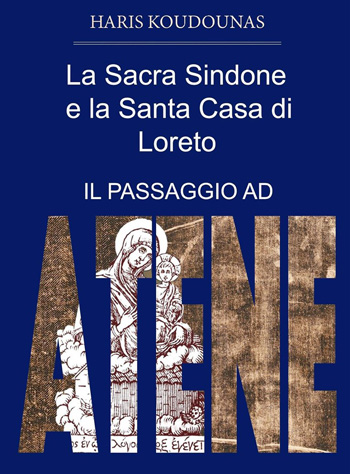
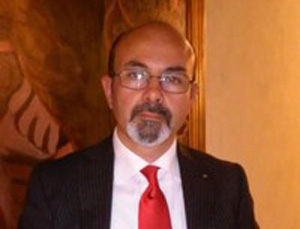 It has been erroneously translated as:
It has been erroneously translated as:
“From the foundations, Immaculate Mother of God, we raise up the saved house, a sacred work.”
Koudounas made a wild conjecture that this was a reference to the Holy House of Nazareth, and that its stones must have been temporarily stored inside this church.
But no conclusion of that nature can be drawn from the inscription for the following reasons.
First, the original wording did not say “saved house” but “saved foundations.” (9)
Second, there is archaeological evidence that the ruins of an ancient temple were located on the site. (10) And we know that recycling used building materials was an ancient and widespread practice, its historical roots going as far back as early Classical Greece. In numerous cases where the spolia from pagan temples were reused in the building of churches, the recycled material was given a Christian interpretation, often symbolizing the defeat of paganism and the victory of Christianity. (11)
Here, the obvious message of the inscription was that the church dedicated to Our Lady was raised from the foundations of the ruined temple.
2. The ‘travelling stones’
There are numerous other areas in his research where Koudounas displays a cavalier approach to serious scholarship, a further example being:
“The discovery of the coins of the Duchy of Athens in Loreto shows that the sacred stones passed through the Duchy, after having arrived by sea from the Port of Acre (Palestine).” (12)
This chain of reasoning is a non sequitur: there is no necessary connection between these alleged events. Besides, it has still not been proved that the Holy House had been dismantled, placed on board a ship and transported through Greece to Loreto.
Conclusion
No reasonable person can be convinced by Koudounas’s thesis. His research was carried out on the basis of “confirmation bias”: He interpreted the data in a manner that confirmed his a priori beliefs, for mixed motives. It appears that Koudounas has positioned himself as Prince Alessio’s most fervent acolyte and the Angeli family’s cheerleader.
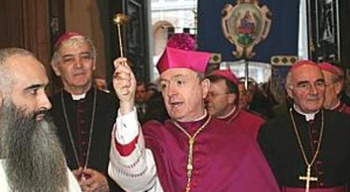 Also, he has presented the Greek Schismatic leaders with ideas they were already predisposed to agree with, and an opportunity to override the Catholic tradition. Greece, not Dalmatia and Italy, would go down in history as the country through which the Holy House passed, while the Angeli family, not the Angels, would henceforth have full credit for effecting its removal. It seems that Koudounas was a modern Prometheus who, in Greek mythology, stole fire from the gods to give it to mortals.
Also, he has presented the Greek Schismatic leaders with ideas they were already predisposed to agree with, and an opportunity to override the Catholic tradition. Greece, not Dalmatia and Italy, would go down in history as the country through which the Holy House passed, while the Angeli family, not the Angels, would henceforth have full credit for effecting its removal. It seems that Koudounas was a modern Prometheus who, in Greek mythology, stole fire from the gods to give it to mortals.
Msgr. Tonucci was no doubt primarily interested in burnishing his credentials as a progressivist Vatican II Bishop by displaying his willingness to engage in “ecumenical” outreach to other faiths. But the price of doing so was the betrayal of the now 800-year-old Loreto tradition
Who can be surprised? Progressivists generally deny unwelcome truths that challenge their ideological dogma. If they cannot accept a supernatural explanation for a historical event, they decide to alter its analysis by rearranging the evidence to suit their new hypothesis.
It is only when “Ecumenism” is finally discarded and integrity restored – which means upholding authentically Catholic values instead of allowing them to be trashed – that we will once again have Catholic leaders worthy of the name.
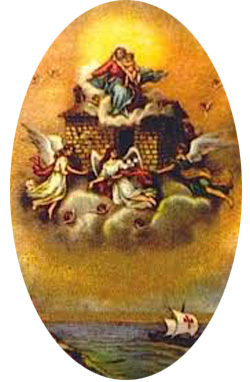
Continued


The ecumenical gathering at Loreto Basilica, with Msgr. Tonucci to (with scarlet belt) representing the Vatican
Metropolitan Gennadios, appealing to abstract concepts of universalism and vague ideals of global unity, described the meeting as a “glorious stage” in Byzantine history. This was a reference to the completely unsupported hypothesis that members of the Schismatic Angeli family were instrumental in transporting the Holy House from Nazareth to Loreto in the 13th century, not via Dalmatia and Italy, but via Athens and various towns in Greece.
But this represents a dilemma for religious unity. Gennadios can hardly be said to have been motivated by benevolence and brotherly sentiments. While living in Italy (his seat was in Naples), he was only interested in promoting Greek nationalism and giving credit to members of his own religion for having transported the Holy House from Nazareth. His approach was simply a form of chauvinist identity politics, an attempt to upstage the Catholic tradition.
In his address, Msgr. Tonucci referred to the Schismatic confessions as “sister Oriental Churches (“le sorelle Chiese orientali”). (1) Casting aside the Catholic tradition of angelic agency, he stated that they have “historical links with the Holy House of Loreto through the events that led to the transfer of the holy stones from the East to the western coasts of the Adriatic.” (2)
Hermeneutic of discontinuity
A significant feature of the Loreto meeting is the complicity of the Pontifical Delegation and its leader in the task of estranging the faithful from their tradition and history of the miraculous translation of the Holy House.

An intent to cast doubt on the Loreto Transportation
The question arises: Was he actively working towards the demise of that tradition? As the defining issue of Loreto was the translation of the Holy House by purely supernatural means, Tonucci’s statement – echoed by Santarelli (3) – is nothing less than the destruction of that tradition. Besides, if the Holy House was transported by ship, where does that leave Our Lady of Loreto as Patroness of air travel?
Paradoxically, this crusade to downplay the miraculous element of the Loreto tradition seeks to place its interpretation in the hands of those outside the fold. It was so successful that all progressivist media outlets, from official Vatican authorities to the Catholic Press and even to secular tourist agencies, now portray the Byzantine Angeli family as the true protagonists in the translation of the Holy House. The Catholic tradition has been eclipsed.
Who started the anti-Loreto legend?
It will come as no surprise to find that it was the Angeli family itself, whose present head is Prince Alessio Angelo Comneno of Thessaly, Greece. He confidently asserted: “‘It was not the heavenly angels, but the Angeli family, who brought the Holy House to Loreto’ ‒ so said my grandfather Michael III [Mario Bernardo Angelo-Comneno] until the end of his days.”

Prince Alessio Comneno interviewed at the 2016 conference in Loreto
So, now we know that the “Angeli thesis” was an in-house construct of relatively recent origin, designed to overthrow the centennial and universal Catholic tradition; and that the Angeli were a family with a mission to arrogate to themselves the glory of the translation of the Holy House. (Hence, we have a possible explanation of the mysterious papers rumored to have been seen in the Vatican Archives at the beginning of the 20th century).
Who organized the inter-faith meeting?
The promoter of this event was Prince Alessio, President of the Accademia Angelica Costantiniana, a cultural institute organized in Rome by his grandfather in 1949. Its self-declared aim was to “promote a bridge between the two worlds, the Latin Catholic and the Eastern Byzantine, and a mutual enrichment of spiritual and cultural values.”
The politics of envy

An intent to promote tourism in Arta (Mallorca) & deviate pilgrimages from Loreto?
“The delegation of the Municipality of Arta had on the sidelines of the Conference important meetings with travel agents, in an effort to find a way to divert the flood of visitors from Loreto to Greece and specifically Arta.” (5)
Is this really what the Church has come to, that the official weight of the Pontifical Delegation was directed to pandering to the politics of envy? In order to meet the appropriate level of “ecumenical” targets to satisfy official Vatican II requirements, it was necessary not only to appease but also to believe and disseminate the ideas of those who intended to destroy the Catholic tradition of Loreto. This was principally the role of Fr. Giuseppe Santarelli.
A 21st-century Trojan horse enters Loreto
In his 2016 book on Loreto, (6) Fr. Santarelli introduced and warmly recommended the work of the Greek writer, Haris Koudounas, a member of the Accademia Angelico Costantiniana, who is the mastermind behind the current promotion of the “Angeli thesis.” In fact, it was his research and published results (7) that led to the Loreto Conference and Ecumenical prayer meeting.
Let us examine the main planks of his argument which, on his own admission, are merely hypotheses.
1. An ancient inscription
Koudounas drew attention to a lapidary inscription he discovered in Pyli, Thessaly, in the church of Porta Panagia, (8) which had been built in 1283 by Joannis I Angelos Comneno, ruler of Thessaly.

Haris Koudounas strives to destroy the Loreto Miracle in his works and interviews

“From the foundations, Immaculate Mother of God, we raise up the saved house, a sacred work.”
Koudounas made a wild conjecture that this was a reference to the Holy House of Nazareth, and that its stones must have been temporarily stored inside this church.
But no conclusion of that nature can be drawn from the inscription for the following reasons.
First, the original wording did not say “saved house” but “saved foundations.” (9)
Second, there is archaeological evidence that the ruins of an ancient temple were located on the site. (10) And we know that recycling used building materials was an ancient and widespread practice, its historical roots going as far back as early Classical Greece. In numerous cases where the spolia from pagan temples were reused in the building of churches, the recycled material was given a Christian interpretation, often symbolizing the defeat of paganism and the victory of Christianity. (11)
Here, the obvious message of the inscription was that the church dedicated to Our Lady was raised from the foundations of the ruined temple.
2. The ‘travelling stones’
There are numerous other areas in his research where Koudounas displays a cavalier approach to serious scholarship, a further example being:
“The discovery of the coins of the Duchy of Athens in Loreto shows that the sacred stones passed through the Duchy, after having arrived by sea from the Port of Acre (Palestine).” (12)
This chain of reasoning is a non sequitur: there is no necessary connection between these alleged events. Besides, it has still not been proved that the Holy House had been dismantled, placed on board a ship and transported through Greece to Loreto.
Conclusion
No reasonable person can be convinced by Koudounas’s thesis. His research was carried out on the basis of “confirmation bias”: He interpreted the data in a manner that confirmed his a priori beliefs, for mixed motives. It appears that Koudounas has positioned himself as Prince Alessio’s most fervent acolyte and the Angeli family’s cheerleader.

Archbishop Tonucci promoting ecumenism at the opening of the Holy Door of Loreto in December 2016
Msgr. Tonucci was no doubt primarily interested in burnishing his credentials as a progressivist Vatican II Bishop by displaying his willingness to engage in “ecumenical” outreach to other faiths. But the price of doing so was the betrayal of the now 800-year-old Loreto tradition
Who can be surprised? Progressivists generally deny unwelcome truths that challenge their ideological dogma. If they cannot accept a supernatural explanation for a historical event, they decide to alter its analysis by rearranging the evidence to suit their new hypothesis.
It is only when “Ecumenism” is finally discarded and integrity restored – which means upholding authentically Catholic values instead of allowing them to be trashed – that we will once again have Catholic leaders worthy of the name.

Continued
- The first Pope to use “sister Churches” to designate both the Catholic and Greek Schismatic religions was Paul VI in his letter, Anno ineunte (1967), to the Patriarch of Constantinople, Athenagoras I. The expression is misleading because it implies that there are many “true” Churches of Christ, and undermines belief in the One, Holy, Catholic and Apostolic Church confessed in the Creed. Here we can see the outline of the development of Vatican II’s deliberately confusing “subsistit” theory that the Catholic Church “subsists” in the Church of Jesus Christ. Besides, the Catholic Church is the “Mother,” not the “sister”, of all particular churches, a term that does not include the confessions of heretics and schismatics.5
- ‘Grande celebrazione a Loreto per i 700 anni della Fondazione della Basilica che ospita la Casa Santa’, La Stampa, March 13, 2016.
- Giuseppe Santarelli, Loreto. L’altra metà di Nazaret, ed. Terra Santa, Milano, 2016.
- Prefazione di S.A.I. e R. Principe Alessio Angelo-Comneno d’Epiro e di Tessaglia, Rome, March 25, 2019, Haris Koudounas, La sacra Sindone e la Santa Casa di Loreto. (Il Passaggio ad Atene), Rome: Edizioni Efesto, 2019
- The article is in Greek only: ‘Συνεργασία για την ανάπτυξη του θρησκευτικού και μνημειακού τουρισμού στην Άρτα’ (Cooperation for the development of religious and architectural tourism in Arta), Epirus Gate, March 7, 2016.
- G. Santarelli, Loreto: L’altra metà di Nazaret: la storia, il mistero e l’arte della santa Casa, Milan: ed. Terra Santa, 2016, pp. 41-42.
- Haris Koudounas, ‘La chiesa bizantina Porta Panagià e la Santa Casa di Loreto: Il ruolo della famiglia degli Angelo Ducas Comneno di Tessaglia e di Epiro’ (The Byzantine Church of Porta Panagia and the Holy House of Loreto: The Role of the Family of Angelo Ducas Comneno of Thessaly and Epirus), Studi sull’Oriente Cristiano, vol. 18, n. 1, 2014, pp. 169-186.
- H. Koudounas, ibid., p. 174. Panagia, literally all holy, was a customary title of the Virgin Mary among the Greek Schismatics.
- The original wording was in ancient Greek: Εκ βάθρων σώον, πάναγνε, στόμεν δόμον, πονυμα ιερόν. The first three words are the key. As εκ βάθρων means “from the ground up,” we can see that the church of Porta Panagia was erected on the foundations of the previous building which were “saved” (σώον), i.e., kept or conserved intact.
- Johannes Koder and Friedrich Hild, Tabula Imperii Byzantini, vol. 1, Hellas und Thessalia, Vienna: Verlag der Österreichischen Akademie der Wissenschaften, 1976, p. 246.
- Helen Saradi, ‘The Use of Ancient Spolia in Byzantine Monuments: the Archaeological and Literary Evidence’, International Journal of the Classical Tradition, vol. 3, n. 4, Spring 1997, p. 395.
- H. Koudounas, Ibid. p. 178.

Posted September 16, 2020
______________________
______________________
 Volume I |
 Volume II |
 Volume III |
 Volume IV |
 Volume V |
 Volume VI |
 Volume VII |
 Volume VIII |
 Volume IX |
 Volume X |
 Volume XI |
 Special Edition |


